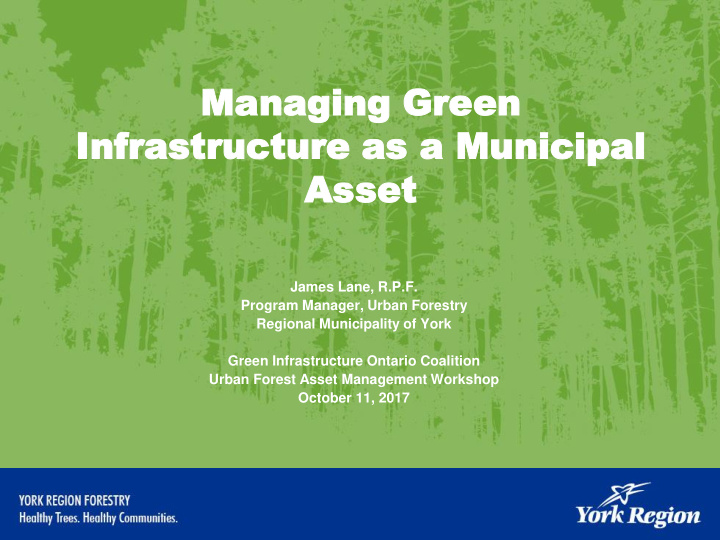



Ma Managing aging Gre reen n Inf nfrastructure rastructure as as a Mu a Municipal nicipal Asse As set James Lane, R.P.F. Program Manager, Urban Forestry Regional Municipality of York Green Infrastructure Ontario Coalition Urban Forest Asset Management Workshop October 11, 2017
Overview • Why manage Green Infrastructure as an asset • Background – Beginnings of Green Infrastructure Asset Management • Green Infrastructure Asset Management Plan • What’s next
Why manage Green Infrastructure as an Asset • Recognize and communicate the benefits provided by Green Infrastructure • Systematic management approach to provide benefits over the long term • Provides a defensible approach to identifying investment requirements
Background – Beginnings of Green Infrastructure Asset Management • 2013 – Green infrastructure included in State of the Infrastructure reporting • 2015 – Green infrastructure reported in second state of the infrastructure report • Green Infrastructure includes: – Street trees – York Regional Forest • Forest communities • Trails, parking lots, signs, etc.
York Region Asset Management Structure
Green Infrastructure Asset Management Plan • Currently finalizing the first asset management plan for green infrastructure • Project Team – Infrastructure Asset Management Branch – Natural Heritage and Forestry – Opus International (consultant) – Silv-Econ (consultant) 6
Asset Management Plan Elements • Key components of the plan will include: – State of the infrastructure – Levels of service – Asset management strategy – Financing strategy – Continuous Improvement 7
Asset Portfolio • Portfolio based on assets managed by division • Assets organized into biological assets and civil assets under three categories: – Urban Forest (street trees) – York Regional Forest – Bill Fisch Forest Stewardship and Education Centre
Asset Portfolio Urban Forest • Biological – street trees, shrubs, perennials and growing media • Civil – soil cells and irrigation systems, drainage York Regional Forest • Biological – vegetation communities (forests, wetlands, prairies) • Civil – trails, parking lots, fences, signs, culverts, etc.
Asset Evaluations – Urban Forest • What is the most appropriate and defensible method to value urban forest biological assets? • Street trees – Use CTLA trunk formula method • Shrubs and perennials – replacement cost • Growing media – replacement cost • Assessed ecosystem services using I Tree Eco
Asset Evaluations – York Regional Forest • What is the most appropriate and defensible method to value Regional Forest biological assets? • Forests – Timber value, land value, re-establishment cost • Wetlands and prairies – land value, re-establishment (future) • Assessed ecosystem services using I Tree Eco
Levels of Service • Identifying levels of service to be provided by green infrastructure was the most challenging element of the plan • Level of service includes: – Community level of service – Technical level of service – Performance measure
Asset Management Strategy • Estimating the useful life of biological assets posed some challenges • Street trees - identify three growing environments and estimate average lifespan – Urban – 35 years – Suburban – 44 years – Rural – 53 years • York Regional Forest – natural communities are self perpetrating (with maintenance)
Asset Management Strategy • Asset management strategy provided opportunity to document our practices in a single source • Provided single source of costing information • Meaningful review of expected growth in programs – particularly challenging
Financial Strategy • Funding plan to put asset management strategies into action, required investment to meet service levels • 100 year forecast with multiple scenario's based on level of growth
Financial Strategy • Modelling shows significant peaks if funding during 100 years • Key outcomes from financials strategy – Need to review service levels and return on investment for some treatments – Need to establish reserve to minimize impacts of funding peaks
What’s Next • Plan identified a number of continuous improvement initiatives: – Stakeholder consultation – Separate operating and maintenance costs – Need for a forestry replacement reserve – Establish data governance model – Improve age and condition data for civil assets • Update plan 3 – 4 years
Qu Ques estion ons / s / Di Disc scus ussi sion on
Recommend
More recommend